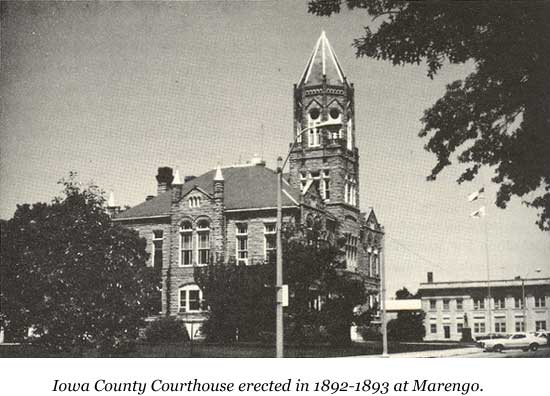| Home | ||
| Records | Research Help | Search | About | |||
| Records :: History: County and Courthouse History | |||
| Home / Records / History / County and Courthouse History | |||
|
Source: Excerpt taken from the pages of: The Counties and Courthouse of Iowa, by LeRoy G. Pratt, Copyright 1977, First Edition
Iowa County (584 square miles) was named for the Iowa River which flows across the county and for the Ioway Indian Tribe, whose name has been variously interpreted to mean “Sleepy Ones,” “Drowsy Ones,” “Dusty Faces,” “Beautiful Land,” or “This Is The Place.” The Ioways were one of the tribes which inhabited Iowa before the coming of the white man. The Mesquakie and Pottawattamie Indians were occupying lands in the northern part of Iowa County when the “pale faces” first came here to settle prior to 1844. In common with most other Iowa counties, the first settlements were made in or near the timber. Marengo, located about eight miles north of the geographical center of the county, was chosen by the locating commissioners as the county seat on August 13, 1845. This event was interestingly described by an account, published in 1881, which stated that when the three persons appointed by the Legislature to select the county seat arrived on the scene in a wagon, they had with them a jug filled with “ague medicine.” One of the commissioners, “who had not only taken a dose sufficient to protect him from the effects of the malarious atmosphere, but enough more to arouse great exuberance of spirits,” stood on the end-gate of the wagon, scanned the country above the tall prairie grass, and shouted at the top of his voice: “This place henceforth, by jingo, shall be called Marengo!” The other commissioners agreed on the place and the name, which was suggested by what they supposed to be a resemblance between the Iowa River valley at this location and the plains of Marengo in northern Italy, where Napoleon Bonaparte was victorious over the Austrians on June 14, 1880. One of the men present is said to have provided a strip of material from the seat of his underwear, which was then fastened to a pole after the name “Marengo” had been written upon it with a piece of red keel. Later in 1845, an order by the county commissioners to change the name of the town to Valley Forge met with considerable opposition and never became effective. After the seat of justice was officially located, it was discovered by the county commissioners that a speculator named Lyon had already bought up the land from the government for $1.25 per acre, with the expectation of selling the land back to the county at an exorbitant price. The commissioners would not submit to demands, however, and the 80 acres were purchased at government prices plus 10 percent interest on the money from the time Lyon had acquired the land. There being no county funds available, the money was obtained by borrowing $50 from William Hench, $45.58 from William Taylor, and the rest in small sums from local citizens. This was barely enough to purchase the 80 acres. These people were repaid by the county in town lots. R.B. Groff was induced to buy another 80 acres which he later deeded to the county, and he also received town lots in payment. Lots were first placed on sale in Marengo on Monday, October 2, 1846. A large piece of sandstone was procured with great difficulty from a bluff along the Iowa River, north of where Bear Creek runs into that stream, and was hauled to Marengo by Lewis F. Wilson. The stone was buried in the southeast corner of the public square, and all distances to the town were computed from this point. Mr. Wilson was paid $2 for his services. The construction of the one-room, log courthouse on the north side of the public square in Marengo in 1847 was not approved by the county officials, but the building was rented and used by the county. At this time the county had a population of 435. By 1850, when the second courthouse was completed, there were 822 inhabitants in the county. This more elaborate building, whose insured value was $200, was located on the east side of the public square and was used until 1861. When a third courthouse was built a few lots north of the previous site, the old courthouse later became known as Readman’s Store. The new courthouse was a brick building costing $2,000. While the county seat has remained at Marengo, there were frequent attempts to relocate it at Genoa Bluffs (in Sumner Township) and Williamsburg (in Troy Township.) In early times, one of the objections to Marengo was flooding from the Iowa River and Bear Creek. It was said, that during one season of the district court, water was two feet deep all around the courthouse and members of the grand jury from Greene and English Townships threw out hooks and lines from the courthouse steps. Upon being questioned by citizens of Marengo, they replied that they were “bobbing for eels.” It was the intention that this would aggravate the local people and make an argument in favor of changing the county seat. An addition to the third courthouse was begun in 1869 and completed “in due course.” But, by 1890, this building was not big enough for conducting county business. Another courthouse was then erected in 1892. This two-story, stone building is in the Romanesque style of architecture, ornamented with turrets and a unique tower. Architects were Foster and Liebbe. The contractor was P.H. Wind of Council Bluffs, and the cost of construction was $57,608. Transcribed by Linda Ziemann, IAGenWeb Coordinator, July 2005 | |||
| Home / Records / History / County and Courthouse History | |||
| Copyright © 2005 IAGenWeb.
All rights reserved. |
|||
